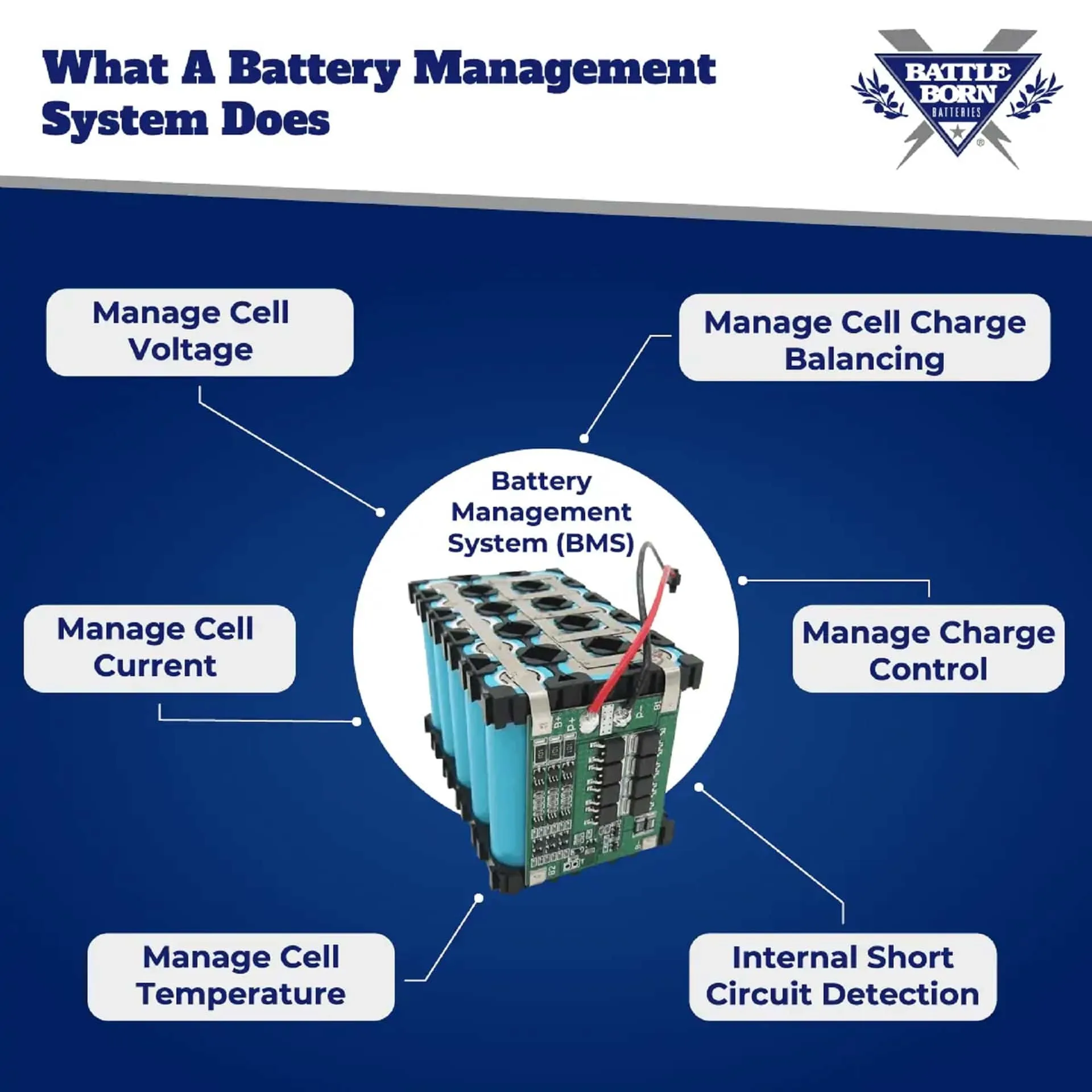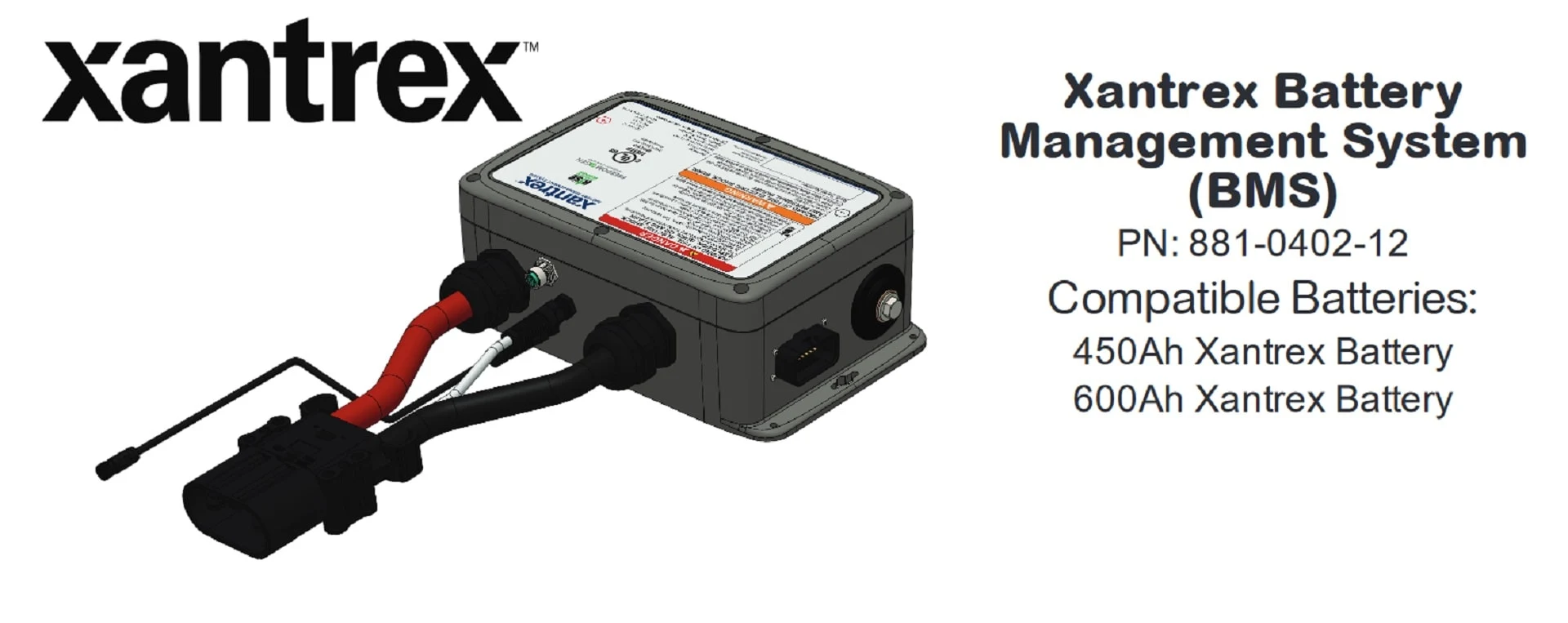Today we’re investigating the function of a battery management system.
Most of us are familiar with lead-acid batteries. They’ve been around since the mid-1800s, so they’re certainly time-tested. But they’re heavy, they require regular maintenance, and even with that, they don’t last as long as newer technology… such as that found in lithium-ion batteries.
Lithium batteries have a significantly longer lifespan than lead-acid batteries do, they’re lighter and more efficient, and they charge faster. With all of that great technology, however, comes a downside. Lithium batteries can be prone to a condition called thermal runaway.
In short, thermal runaway occurs when the temperature inside a battery rises to the point of causing a chemical reaction that produces excessive heat, causing another chemical reaction that in turn creates even more heat. The heat generated quickly exceeds the amount of heat the battery can release. This is a chain reaction that can occur suddenly and quickly (within milliseconds) and is very difficult to stop once it has started, (thus the term “runaway”).
The energy stored inside the battery is released very suddenly and can cause an explosion and a fire of such high temperatures (in excess of 750° Fahrenheit, 400° Celsius), that it’s near-impossible to extinguish.

A battery management system exists to prevent thermal runaway from causing a battery explosion and inextinguishable fire.
It’s important to note that thermal runaway can happen in any type of battery (including traditional flooded lead-acid batteries), but it’s more commonly associated with lithium batteries. And even though the most commonly used lithium battery chemistry (Lithium Iron Phosphate, or LiFePO4) isn’t particularly prone to thermal runaway, it’s still the reason why most lithium batteries have a battery management system that acts as a control center for the battery, ensuring that it always operates in safe conditions.
- 1) What Is a Battery Management System (BMS)?
- 2) What Is the Primary Function of a Battery Management System?
- 3) How Does a Battery Management System Work?
- 4) Why Is a Battery Management System Necessary?
- 5) What Kind of Protection Is Offered By a Battery Management System?
- 6) Final Thoughts on the Importance of a BMS
What Is a Battery Management System (BMS)?
A battery management system (BMS) monitors and manages the advanced features of a battery, ensuring that the battery operates within its safety margins. The BMS serves as the brain of a battery pack. A BMS is not only critical to the safe operation of a battery, it’s also critical to a battery’s optimal performance and longevity.
The BMS can be internal to the battery (as is the case with all Battle Born batteries as well as with the 105/125Ah Xantrex batteries), or it can be external to the battery (like the BMS on our large Xantrex eGEN battery).
What Is the Primary Function of a Battery Management System?
The primary function of a battery management system is to protect the lithium cells from excessive heat or cold, voltages that are too high or too low, and shorts that can occur in the system. The BMS offers protection to the lithium-ion cells by shutting down the battery if any of these events occur. (Battle Born’s built-in BMS also offers protection against faults.)
Another function of a BMS is to regulate the amount of power drawn from the battery to keep the battery’s cells in optimal balance. This is partially a safety feature but also contributes to the overall health and longevity of the battery.
How Does a Battery Management System Work?
A BMS monitors each cell within a battery pack (all current lithium batteries for RVs contain a number of smaller “cells” that are wired together to provide the desired power output for the battery), calculating the safe amount of current going in (battery charging) and coming out (discharging) ensuring that no damage is caused to the battery. This is how the BMS offers protection from excessively high or low cell voltages, increasing the longevity of the battery.

This overview of how a battery management system works is provided by Battle Born Batteries, a leader in the lithium battery industry. (Photo and chart courtesy of Battle Born Batteries.)
So, with a battery management system, the amount of energy entering and exiting the battery pack is tracked and all cell voltages are constantly monitored. This is also how the BMS calculates the amount of energy remaining in the battery at any given time (state of charge).
The BMS is also always monitoring the battery for issues such as shorts, loose connections, wire insulation damage, or cells that require replacement.
A battery is only as strong as its weakest cell, so keeping the cells in balance is an important feature of the BMS.
The BMS monitors the battery’s temperature, which it may then regulate by stopping incoming/outgoing current or with a fan.
And finally, it provides real-time data and stores error codes and diagnostics, which it can send directly to external displays, chargers & motor controllers, dedicated apps on smartphones (through BlueTooth), and other data loggers… depending on the features offered by the battery manufacturer.

Xantrex, another strong leader in the lithium battery industry, uses a sophisticated external battery management system with their 450Ah and 600Ah batteries. (Photo credit: Xantrex)
Why Is a Battery Management System Necessary?
A battery management system is a critical safety system that must be employed due to the thermal runaway potential of lithium batteries in particular. The batteries need to be constantly operating at optimal levels and within specific safety limits in order to prevent any possibility of explosion and fire.
So, a BMS is necessary as a safety mechanism, and it also serves to protect the overall health and longevity of the battery.
What Kind of Protection Is Offered By a Battery Management System?
Briefly reviewing the most important protections offered by a BMS, we can summarize them as protection from under- or over-voltage, extreme temperatures, and shorts that can occur for any number of reasons.
Under/Over Voltage
This protection is important because if a lithium-ion battery cell runs above or below its minimum operating value, the cell will be damaged.
A BMS protects the battery’s cells from damage by disallowing under-voltage and overvoltage conditions.
Extreme Temperatures
Keeping temperatures within certain limits is critical to the safety and stability of lithium-ion battery cells, because thermal runaway (a rapid explosion and fire) can occur if critical temperature levels (high or low) are exceeded. In most batteries, when extreme temperatures conditions are detected, the BMS will stop the flow of current into/out of the battery, ensuring that no damage can occur.
Shorts
Thermal runaway can also be caused by internal and external shorts, so a battery management system’s ability to protect a battery from shorts is another critical safety feature.
Final Thoughts on the Importance of a BMS

We’ve loved our Xantrex Freedom eGEN battery’s performance, and we have great respect for the extensive protection offered by Xantrex’s battery management system.
We love our Xantrex Freedom eGEN lithium battery system and while we appreciate the advanced technology that keeps us boondocking happily year after year, we also respect the nature of lithium battery technology. We understand that lithium battery cells require constant monitoring, balancing, and management for safety as well as for the overall health and longevity of the system.
For these reasons, we have a great appreciation for the technology behind battery management systems that we rely on to maintain the safe operation and optimal performance of our battery over time. And we hope we’ve answered the question of “What is the function of a battery management system” for you!
Geek Out with Us Every Week
Join our newsletter to learn about all things RV-related. Every week we offer free tips, tricks, product reviews, and more to our online community of RVers. So, whether this is your first time on the road or you’re a seasoned expert, we’d love for you to geek out with us!


Syed Mahmood
Sunday 8th of October 2023
I bought 24V/200AH Lithium ion Phosphate battery pack, my solar inverter have setting, if battery pack voltage reach to 23V,it will shift the load from battery pack to utility power. That time I measured the battery voltage, found 23.5V,and inverter was showing battery is connected but not in use, after 30 minutes alarm appears on inverter, the battery is not connected, that time I measured the battery voltage found zero. Now inverter is not recognize the presence of battery, so it is not giving charging voltage. What is the problem? Please send me reply in my emails.
jude
Saturday 6th of August 2022
you say all lithium batteries are composed of many small cells. my ecotreks are 200Ahr and composed of 4 large cells. can you tell me any advantages to very small number of cells? Also one site said with many cells one can go bad without loosing the battery, this site says the opposite....???
TheRVgeeks
Saturday 6th of August 2022
Hi Jude. We didn't actually say that lithium batteries are made up of "many small cells"... we just said that each battery is made up of SMALLER cells. How many cells are used varies by manufacturer. But the point is that when you buy a 12V lithium battery, it's not just one big battery cell. And we can't find anywhere in our article where we mentioned that if one cell goes bad the whole battery is lost. But, having many, smaller cells would certainly reduce the impact of any one cell failing. It's just a matter of percentages. If you have a single battery with only 2 cells, and one goes bad, you've lost 50% of your battery's capacity (if it would even function). While if you have 20 cells, losing one is only 5% of the capacity.
hclarkx
Friday 4th of March 2022
It's very unfortunate that the industry uses the word "manage" in regard to the lithium battery "BMS." About the closest a BMS comes to "managing" something is to apply balancing when needed. In reality, all functions including balancing are protective in nature. I.e., protecting the battery from damage that would shorten the life or cause thermal runaway. BPS would have been a better term. Users often assume that a BMS will limit charge current when it does not; it simply turns off the charge current if there's a problem to protect the battery.